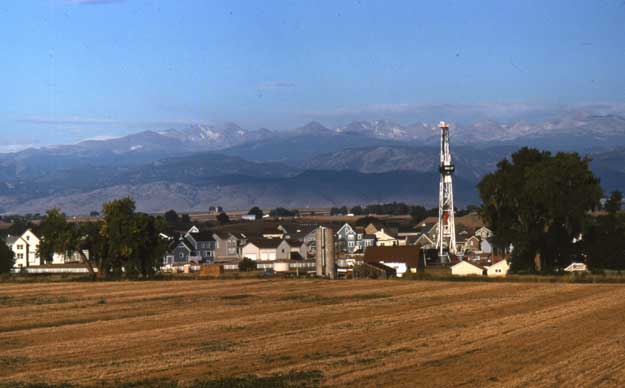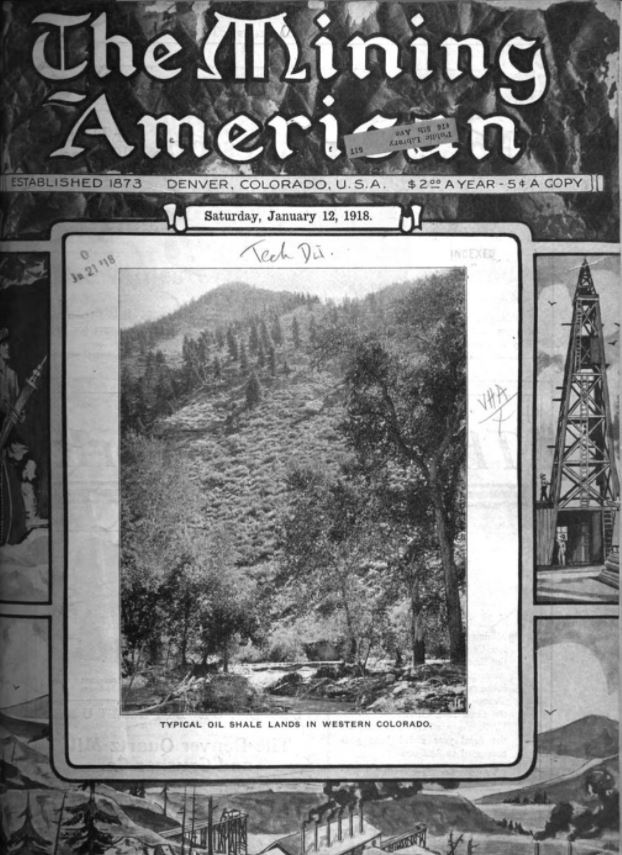Oil stock certificate from 1901 helps tell story of the Boulder oilfield and early Colorado discoveries.
Colorado oil history revealed from researching an old oil company stock certificate.
Dated March 1902, a stock certificate had been issued by a Wyoming venture — the Savannah Oil, Coal and Gas Company. The company president’s signature was too hard to make out, according to the guest post on the the American Oil and Gas Historical Society (AOGHS) Stock Certificate Q & A Forum — a popular section of Is My Old Oil Stock worth Anything?
The poster added: “I would appreciate any information available on this company. Researching for my 90-year-old Mom!” Like many others, the visitor to AOGHS website sought information about his family’s stock certificate.

Drilling for natural gas in 2005 in the Denver Basin’s Wattenberg gas field, discovered in 1970. Photo courtesy geologist and engineer Dan Plazak.
The story of Savannah Oil, Coal and Gas began just before its incorporation — when a headline-making oilfield discovery at Boulder, Colorado, inspired the founding of many exploration companies. Most of these ventures would not survive.
According to a 1902 biennial report from the Colorado Secretary of State, Savannah Oil, Coal and Gas Company had a principal office in Cheyenne, Wyoming, for doing business in Colorado. The also report listed a T.F. Little as a sales agent with Boulder as a place of business.
Boulder Oilfield
Natural oil seeps first drew “bobbers” to the Boulder area, according to a 1905 Colorado Geological Survey report.
“The principle on which the use of a bobber rests is the same as that by which the proper site of a water well is determined by the involuntary turning of a witch-hazel sprout when held in the hand,” the survey noted.
In the Boulder field, bobbers fixed “the exact location off a large proportion of the wells, the geological survey added. One such oil well was on the McKenzie farm, about three miles northeast of town. It was the discovery well that opened the Boulder oilfield — the first of many in the Denver Basin.
The McKenzie well that launched drilling in Boulder field would pump oil until 2007.
Initially producing 70 barrels of oil a day, the 1901 McKenzie well spawned a scramble for nearby mineral leases as the local newspaper, The Daily Camera, reported a thousand companies formed in three months. Savannah Oil, Coal, and Gas Company was among them.
Despite the disdain of petroleum geologists, modern bobbers and other dowsing tools are available from the American Society of Dowsers (ASD), established in 1961. For attempts of finding Texas oilfields using psychic readings, see Luling Oil Museum and Crudoleum.
Savannah Oil, Coal, and Gas
Savannah Oil, Coal, and Gas incorporated on February 11, 1902, with C.B. Younglove as president and its principal agent in Boulder. The vice president was T.F. Little.
Capitalized at only $15,000 with its main office in Cheyenne, Wyoming, the company needed early success in the Boulder oilfield to survive. When Younglove learned the Otero Company had drilled and completed producing oil wells northeast of Boulder, he managed to secure leases close by.
Savannah Oil, Coal, and Gas Company would drill in Boulder County’s Section 8 and Section 9, Township 1 North, Range 70 West (Public Land Survey System – PLLS). Today, the well sites are near the intersection of Valhalla Drive and Kelso Road.
By late 1902, a business journal reported Savannah Oil, Coal, and Gas drilling for oil in the Boulder field.
“T.F. Little, the vice president says they have one well 2,600 feet deep with about 1,000 feet of oil in it, and have recently moved derrick to land adjoining the Otero well (which is now producing about 100 barrels per day), and the run hole is now about 300 feet deep, just over the fence from the Otero property,” noted the American Investor, adding Vice President Little, “also says they are not now offering any stock for sale.”
By 1905, the U. S. Geological Survey (Bulletin No. 265) published more detail on the Younglove and Savannah producing oil wells, depths, unsuccessful attempts or “dry holes,” and use of nitroglycerin for fracturing oil-producing geologic formations (learn more in Shooters – A Fracking History).

Citing earlier wells drilled by the Savannah Oil, Coal, and Gas Company, Mining American magazine in 1918 noted, “Possibilities of Greater Production in Boulder Oil Fields,”
The first three wells of Savannah Oil, Coal, and Gas produced enough oil to support more drilling in the booming Boulder field. After production peaked in 1909 at more about 85,000 barrels of oil, some people would claim Boulder made Colorado oil history as, “one of the wildest, crookedest, and most disastrous booms.”
Local historian Silvia Pettem summarized, “Although the oil under the land northeast of Boulder was real, no amount of drilling could keep up with inflated expectations. In just a few months, the bottom fell out of the market.”
Although C.B. Younglove and T.F. Little’s Savannah Oil, Coal, and Gas Company would fade away, by World War I, Mining American magazine teased speculative investors with “Possibilities of Greater Production in Boulder Oil Fields” (January 5, 1918), citing the exploratory wells of Savannah Oil, Coal, and Gas. The magazine proclaimed, “Recent Survey Encourages Deeper Drilling…Younglove Well Commended by Expert.”
But the Boulder boom was already part of U.S. petroleum history. So was Savannah Oil, Coal, and Gas Company.
First Colorado Oil Well
The first commercially successful Colorado oil well was drilled in January 1862 near the mining supply town of Cañon City, about 45 miles southwest of Colorado Springs. The well produced oil just three years after the first U.S. oil well, which was drilled in Titusville, Pennsylvania, by Edwin L. Drake for the Seneca Oil Company of New Haven, Connecticut.
In 1860, businessman Gabriel Bowen had established what many consider Colorado’s first oil venture, the G. Bowen & Company. Bowen claimed ownership of natural oil seeps at Oil Spring — above what would later prove to be the Florence oilfield.
However, Bowen’s claim, “apparently was jumped in the winter of 1860-61 by J.L. Dunn, who dug four pits at the spring,” according to Colorado Encyclopedia. “One of the pits produced a barrel per day, but the others yielded little. Dunn left the area in early 1861, after being charged with cattle rustling.”
Although Bowen regained control of Oil Spring, Alexander Cassidy bought the claim in January 1862 and formed the Colorado Oil Company, “the state’s first commercially productive oil enterprise,” the encyclopedia noted in 2021. Cassidy’s well produced “at most a few barrels per day, which the company sold in Cañon City, Denver, and Santa Fe.”
With wells reaching a depth of 1,445 feet by the 1890s, production in Colorado’s Florence oilfield would peak at more than 3,000 barrels of oil per day.
_______________________
Recommended Reading: Geology of the Boulder district, Colorado: USGS Bulletin 265 (2013); High Altitude Energy: A History of Fossil Fuels in Colorado (2002). Your Amazon purchase benefits the American Oil & Gas Historical Society. As an Amazon Associate, AOGHS earns a commission from qualifying purchases.
_______________________
The American Oil & Gas Historical Society (AOGHS) preserves U.S. petroleum history. Join today as an AOGHS annual supporting member. Help maintain this energy education website and expand historical research. For more information, contact bawells@aoghs.org. Copyright © 2023 Bruce A. Wells. All rights reserved.
Citation Information – Article Title: “Exploring Boulder Oilfield History.” Authors: B.A. Wells and K.L. Wells. Website Name: American Oil & Gas Historical Society. URL: https://aoghs.org/oil-almanac/oil-riches-of-merriman-baptist-church. Last Updated: August 6, 2022. Original Published Date: August 24, 2021, 2021.


